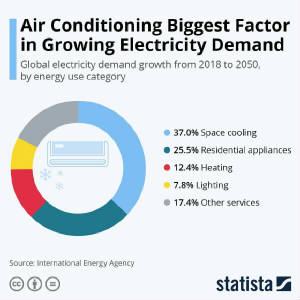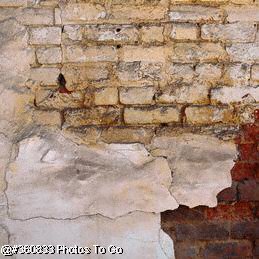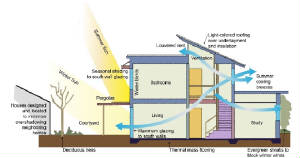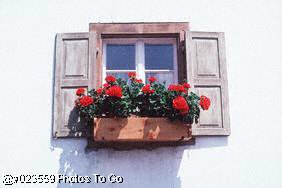|
BUILDINGS CREATE 39% CARBON/GAS EMISSIONS - WORLDWIDE
| GLOBAL ELECTRICITY DEMAND=CARBON/GAS EMISSION RISE |

|
| 2018 - 2050 Emissions - World Economic Forum (2021) |
"Buildings represent 39% of global greenhouse gas emissions, including 28% in operational emissions and 11%
in building materials and construction.
Global building floor space is projected to double by 2060 and only 3% of investment in new construction
is green and efficient, locking in high emissions for decades. The renovation rate for existing buildings is
barely 1%, less than a third of the rate needed to meet the Paris climate goals."
"The Straight Skinny on Baltimore's Slim Row Houses" - "Tiny House Hunting"
"Baltimore Row Home" - All I Need - "House Hunters"
This page explains in detail net-zero and net-positive, the general pathway to renovating a house, and materials needed.
It is important, especially with 15,000 houses, that each one is fully inspected, and allowing apprentices to go with the
engineers is vital to Baltimore's Workforce thriving.
| THE FUTURE: CANALS, STREETCARS, FEW CARS, NO BUSES |

|
| "Net-Zero Living: How Your Day Will Look in a Carbon-Neutral World" - NEW SCIENTIST |
"The Simple Genius of a Prefabricated House - My Net Zero Home Build" - Matt Ferrell, UI/UX Designer (2022)
" The soul of a laborer labors for him, when his mouth forces him." = "כונֶ֣פֶשׁ
עָ֖מֵל עָ֣מְלָה לּ֑וֹ
כִּֽי־אָכַ֖ף עָלָ֣יו
פִּֽיהוּ" - Proverbs 16:26
[More Clearly]
" He who labors labors for himself; for his hungry mouth drives him on." - Proverbs 16:26
COLLECTIVE EFFORT: WHO ARE THE PEOPLE WHO BUILD HOUSES?
1. Floor Plans - Blueprints: Architect and Designers
2. Foundation and Exterior Stairs: Stone and Brick Masons
3. Trusses, Beams, Columns, Joists...: Carpenters
4. Roof: Carpenters and Roof Installers
5. Gutters and Rain-barrels - Water Collection: Roof Installers
6. Exterior Walls: Stone and Brick Masons and Carpenters
7. Interior Walls, Lath, Floors, and Ceilings: Carpenters
8. Insulation: Roofers, Carpenters, Window installers
9. Interior stairs: Carpenters
10. Electricity: Electrician
11. Door Framing and Doors and Window Frames and Sills
12. Windows and Security Shutters
13. Inside/Outside: Storm/Screen/Security doors
14. Pipes, Sewage, and Water/Waterless Heating: Plumbers
15. Heating and Cooling: Plumbers and HVAC Installers
16. Plaster: Plasterers
17. Cabinets and other Built-ins: Carpenters
18. Painter: Painters
19. Toilet Installations: Plumbers
20. Bathroom and Kitchen Backsplash and Tiles: Tilers
21. Kitchen Appliances: Installers from company purchased
22. Yard - Gardening: Gardeners, Landscapers
1. HOUSE ASSESSMENT
Each house needs to have an engineer go over the entire dwelling and list in inspection its state, what is still usable and
stays in/with the structure, and what needs to be removed. Clearly mark every piece that is to be removed securely. Goal
is to not have one single mistake. Engineer oversees pieces to be removed so that structure is deemed, "Sound"
and "Safe" to move to next step; addressing the foundation and basement floor.
2. ALITTLE DECONSTRUCTION FOR CONTRUCTION MATERIALS
Whatever the engineer inspection shows, those things are to be removed from the houses. Be double sure that all are clearly
marked, as do not want a single mistake or harm to the building, or persons working. Remove the materials so can be refurbished
for use back into the houses. Example, sand lumber smooth.

3. MASONS REMORTAR FOUNDATIONS
Most houses, especially town and rowhouses were built with foundations made by boulders usually found through digging right
where the house was to be built. Brick was also used. Stone and brick foundations have been found to be superior to concrete
foundations, as concrete foundations crack and trap radon inside houses. Radon is an odorless, tasteless, colorless gas that
is deadly, and causes lung cancer. Radon naturally is released from the earth, and through your basement is no exception.
So it gets trapped. As a whole, Baltimore City has few concrete foundations, so our radon rating is low compared to the
Baltimore Region - our suburbs.
The proper way to weatherize stone and brick foundations is to re-mortar, making sure that the mortar that is placed inside
connects to the mortar placed on outer side, to insure no holes. It is important that the mason take a sample of the original
mortar as it has to be the same mortar materials. Lime is common. Lime wicks water vapor out. Sometimes horse hair is found.
Concrete will crack and flake - and any mason that says that, "Concrete is alright" is one you do not want to touch your
foundation or any walls again. There are many who will attempt to get owners to put fancy French drains outside and inside
a home, place stones to make it look nice inside, especially when the water collects, as well as a sump pump. Dry-lock is
usually recommended, so painting is required, but no where near low paint costs, even when doing it yourself. Foam and even
plastic bags are tempting, but not a solution. Foam can even have HFC's, a refrigerant that is being banned for use in USA,
so especially do not use. Focusing on re-mortaring and determining the condition of one's house perimeter regarding where
plants are situated, where gutter guards are needed, and where water should be veered to are economical and smart choices.
Masons can give workmanship guarantees, so do not worry. Unfortunately, there are people who were either not taught correctly,
or know fully well, and found ways to make money, however they can.
That being said, if you live in a high-flood area, slope your yard down, so water collects at the farthest points away from
your foundation. Then try an exterior French drain. A sump pump may be necessary if the situation is too bad; due to global
warming and climate change. The frequency of more floods is something to face, and ponder as to whether it is worth continuing
to live in a flood zone.
"This wall is good for another one hundred years." - General Contractor Tom Silva
"The stones of the foundation literally came out of the floor here... When these stones were laid, believe it or not,
they were actually dry-laid {no mortar holding them up}... Back in the day, the builders had a great sense of what we call
today, 'Water Management,' basically keeping the water away from the house." - Mason Mark McCullough
"How to Repoint a Brick Foundation" - "This Old House"
Stone Foundation Repair: Cellar Door - Mike Haduck [Part 1]
"Field Stone Foundations" -Rock Solid Inspector - A Damp Basement is not a Leaking Basement. Use a dehumidifier. (2021)
Recommends to not use plastic connections, as the accordion portion inside - the ridges will collect debris and clog.
"How to Grade Around a Foundation" - "This Old House"
Used concrete for Stone Foundation, created two feet across inside French drains, directs water to come inside the house,
and uses concrete as a paint on the stone foundation. Criminally costly. Not a thought to the slope of land.....
Stone Foundation Repair: Wall - Mike Haduck [Part 2]
Stone Foundation Repair: Varous Wall Materials & Removing oil pipes - Mike Haduck [Part 4]
Stone Foundation Repair: Walls & Floors - Mike Haduck [Part 5]
Stone Foundation Repair: Under the Porch - Mike Haduck [Part 6]
Stone Foundation Repair: Cellar Door Entrance - Mike Haduck [Part 7]
Stone Foundation Repair: About Mine Rock - Mike Haduck [Part 8]
Stone Foundation Repair: Walls & Floors - Mike Haduck [Part 5]
Stone Foundation Repair: Exterior Wall - Mike Haduck [Part ]
4. DESIGNING WITH COOLING TECHNIQUES & WIND REDUCTION
| PASSIVE COOLING TECHNIQUES DIAGRAM |

|
| BUILDING AMERICA SOLUTION CENTER ~ OFFICE OF ENERGY EFFICIENCY & RENEWABLE ENERGY - ENERGY.GOV |
| NEW PAGE |

|
| PLEASE VIEW WHAT IS AVAILABLE ~ COMING SOON |
HOME ENERGY
International Ground Source Heat Pump Association (IGSHPA): Training
"Geothermal Heat Pump Systems" - by TerraSource Geothermal
"How does a Geothermal Heat Pump work?" - Ashgrove Renewables
"What is a Heat Pump?"
"How a Heat Pump Works" - "This Old House"
"Heat pumps, powered by low‐emissions electricity, are the central technology in the global transition to secure and
sustainable heating. Heat pumps currently available on the market are three‐to‐five times more energy efficient
than natural gas boilers. They reduce households’ exposure to fossil fuel price spikes, which has been made all the
more urgent by the ongoing global energy crisis. Over one‐sixth of global natural gas demand is for heating in buildings
– in the European Union, this number is one‐third. Many heat pumps can provide cooling, too, which eliminates
the need for a separate air conditioner for the 2.6 billion people who will live in regions requiring heating and cooling
by 2050. Heating in buildings is responsible for 4 gigatonnes (Gt) of CO2 emissions annually – 10% of global emissions.
Installing heat pumps instead of a fossil‐fuel‐based boilers significantly reduces greenhouse gas emissions in
all major heating markets, even with the current electricity generation mix— an advantage that will increase further
as electricity systems decarbonise. ....
With today’s refrigerants, heat pumps still reduce greenhouse gas emissions by at least 20% compared with a gas boiler,
even when running on emissions‐intensive electricity. This reduction can be as large as 80% in countries with cleaner
electricity.
The Future of Heat Pumps: Heat Pumps are a Proven Way to Provide Secure and Sustainable Heating" - Executive Summary - International
Energy Agency (IEA)
"The Heat Pump Market, Research and Policy in Norway" -Technology Collaboration Programme, IEA
"Heat Pumps: How Norwegians Pay Less for Heating" - Life in Norway (2022)
"District Heating in Norway: How Norwegian Cities Keep Warm" - Life in Norway (2022)
Technology Collaboration Programme on Heat Pumping Technologies
International Energy Agency (IEA)
The 15th IEA Heat Pump Conference in Vienna, Austria 26-29 May, 2026
"What Germany Can Teach Us About Home Energy" - "Ask This Old House"
"Innovative Geothermal Drilling Technology" - IEA Geothermal 0 Dresden, Germany - IEA Geothermal
"Drilling into the geothermal future: the Landmark Success of the First Deep Deviated Well" - Forge Utah

5. WINDOWS
Many casement windows come with low-E glass that blocks out dangerous Ultra Violet rays.
"Casement Windows" - Office of Energy Efficiency & Renewable Energy - U.S. Department of Energy
"Low E Exterior Storm Windows" - Office of Energy Efficiency & Renewable Energy - U.S. Department of Energy
ROOFS
"Fiddler on the Roof" - The Playmates
EXTERIOR STAIRS
Stone Steps - Man Made - Mike Haduck [Part 9]
"How to Build a Stone Bird Bath" - "Ask This Old House"
"How To Build a Stone Water Fountain" - "Ask This Old House"
"How to Build a Treehouse" - "This Old House"
"Where is Norm Abram today? What is he doing now?"
"Tips From Master Carpenter Norm Abram" - WOOD Magazine
"How to Build a Bookcase" - "New Yankee Workshop" - Master Carpenter Norm Abram [S1-E8]
"The Importance of Preserving the Skilled Trades in the 21st Century" at Early American Industries Association (EAIA) - Master
Carpenter Norm Abram
"Inspiring the Next Generation of Skilled Workers" - Master Carpenter Norm Abram and Nathan Gilbert
Samuel Wing: "19th Century Cabinet Making: the Samuel Wing collection at Old Sturbridge Village"
"A No-Cost Rooftop Solar Stimulus: How streamlining residential solar installations can jumpstart a green economic recovery"
- [California leads the way]
Recommendation: to install rooftop solar panels like an appliance; a washing machine. Use California for laws, permits.
Assembly line installations through volume drives down the cost - like in Germany.
"Why are So Many New Buildings Covered in Rectangles?" - Vox
"One Future" - BNIM [Art & Architecture]
...........................................................................................................................................................................................................................................................................................................................
1. Re-mortar stones and bricks. Seek below, WWWWWWWW
2. Use hydronic radiant floor heating. This is the least expensive to install. It can be hooked up to a traditional heat
pump, and a geothermal heat pump. Radiant heat heats the person, not the air. There are no stops and starts like a furnace
does. There are no drafty areas. Hydronic panels and piping can also be placed in ceilings under the floor of upper level,
so as being able to keep floors intact. Hydronic Radian Flooring lasts for 50 years, little to no maintenance, saves
a lot of money and waiting time for appointments (a couple of new furnaces, lots of maintenance....), no gassy dangerous fumes,
takes pressure off chimneys as no longer used (used in future for individual wind turbine - but another topic), no space-stealing
ducts, especially for tall people, no dirty ducts to clean, no holes in your floors with vents that can cut into your feet,
and, most HUMONGOUS reason; they help soundproof! Ducts create noise. Come on now, haven't you ever pressed your ear to
a vent to hear a conversation? Leaned over hear through a hollow-duct wall?
Make a birdhouse. Make a teapoy.
THE PARTNERSHIPS
This Old House - Old House and Building Expertise, Knowledge of USA Filming: Baltimore Promotion
Mike Row - Scholarships for Trades
Habitat for Humanity - assembly line, streamline experience
International Ground Source Heat Pump Association - Accredited Training for Geothermal installations, systems Will come
to Baltimore to train.
International Ground Source Heat Pump Association (IGSHPA): Training
"Drilling in granite like butter" - "Megastructures" - National Geographic
LADY ASBESTOS - FIND PICTURE FOR WEBSITE
WOULD YOU USE ASBESTOS TODAY? OF COURSE NOT. BUT JUST LIKE when asbestos was finally banned in 1978, we are still dealing
with it and its affects. TODAY, there are materials we can no longer use too. They may not be as dangerous, but they keep
houses from being as efficient and sound as they can be.
"How an Asphalt Plant Works" - Duval Asphalt
"Out In The Coal Patch: Life in the Coal Mining Towns of Western Pennsylvania" - Oakmont Historical Society
Maryland has over 300 active mines. According to the 2017 U.S. Economic Census, 28 firms claim operating mines with employing
846 people; paying them combined $57 million.
"The Mountain That Was - Frostburg, Maryland" - Potomac Passage Oolikhanna
Notice that there are no living creatures - fish....
Maryland's largest producer of bituminous coal. A subsidiary of Alliance Coal LLC/Alliance Resource Partners, L.P. with operations
in Maryland, Kentucky, Illinois, Indiana and West Virginia.
"How to Identify a Forged Anvil" - Essential Craftsman
GOVERNMENT
"Building Code - Cool Roofs" 2023
|
